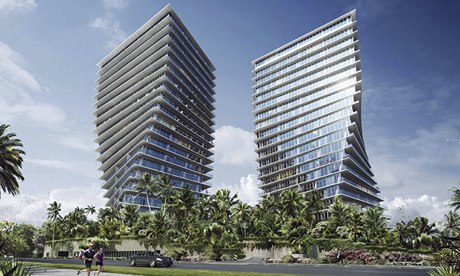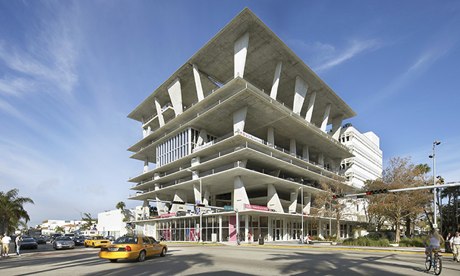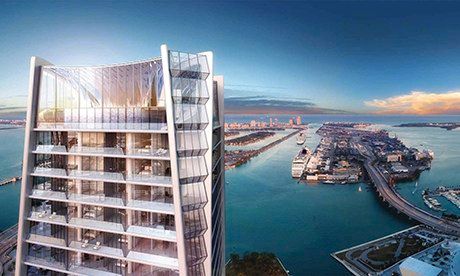Photo above : Zaha Hadid’s One Thousand Museum. By Zaha Hadid.
Film bellow : pre construction of One Thousand Museum. Film above : a randering presentation of One Thousand Musem
If you stand under the broad roof, which extends like an oblong parasol over the new Pérez Art Museum in Miami, you will see: highway bridges streaming with traffic towards Miami Beach, cruise ships arriving in the harbour, architectural relics that count as historic – that is, 1920s – the site of a future science museum by the British architects Grimshaw, an expanse of mud that will eventually be a public park, palm trees and an array of towers that will soon be joined by One Thousand Museum, a bondage-trussed tower with helipad, “sunrise” and “sunset” pools and “the best security in Miami”, designed by the practice of Zaha Hadid. The new building frames it all generously, without passing judgment, giving focus to the disparate parts.
It is a panorama of a young city that lives off ocean and climate, and is connected by cars, and on to which new wealth and new trophies are descending. The view is framed by culture, something for which Miami has not previously been famous. It sums up a place that, as property developers, architects and journalists will quickly tell you, is becoming the new Most Exciting City in America. For the way it captures global forces, not always of the nicest sort, and pushes them into local moulds, it is easy to agree. Robert Wennett, a property player who is trying to realise a Rem Koolhaas-designed convention centre, says that Miami was once about one thing at a time – tourism, gambling, retirement – but now is acquiring multiple layers: “You had a place with no culture that was just basically in the sun, but it grows up and becomes a real city.” There is also, he says, a “food craze”, in his opinion the prime index of a city’s buoyancy.
With its ocean and mostly delightful climate, it’s a good question why Miami has not been greater earlier, but it always found ways to put people off – riots, urban blight, drug dealing. As was pointed out recently in the Huffington Post, movies about Miami tend to be either diverting tales set in hotels (A Hole in the Head, Some Like It Hot, Moon Over Miami), or vicious crime dramas (Scarface, Cocaine Cowboys). Its best known eponymous cultural artefact is the television series Miami Vice, which artfully combined evil-doing with glamorous beaches and speedboats.
The city has featured, still does, in moments of disreputable politics, often with a racial tinge. But it has also discovered that its cultural diversity, arising from the fact it faces the Caribbean and South America, is a strength and a selling point. The Little Haiti district of modest houses and bright street art is a tourist attraction. With its Cuban and other immigrant populations, it is a city as much of the southern as northern of the paired continents and, as Latin America becomes one of the optimistic places on Earth, relatively speaking, so does Miami. “How’s your Spanish?” asks a politically incorrect official at JFK airport, when he sees where I’m going. “You’ll need it.”
Its resurgence is partly, a lot, about money, specifically money invested in property. Like all of Florida, Miami was hit hard by the 2008 crisis, but has bounced back. Miami is in effect a tax haven, whose business people welcome the election of the left-leaning Bill de Blasio as mayor of New York, on the basis that he will raise taxes that will drive more hedge-fund managers south. They liked Hugo Chávez, for pushing the refugee capital of wealthy Venezuelans their way. Miami also does well when Latin America prospers.
The city has become a drop-off point for the migrant tribe of global super-rich, who feel the need to keep homes in London, New York, perhaps Moscow or an Asian city, and now Miami. Hence a sprouting of towers and blocks designed by celebrity architects such as Norman Foster, Richard Meier, John Pawson, Herzog and de Meuron, and the Mexican Enrique Norten as well as Zaha Hadid. I am given the sales pitch, which is like going through a car wash on foot, on two twisted towers designed by the Danish whizzkid Bjarke Ingels and his practice BIG. Called Grove at Grand Bay, they include penthouse flats of 11,000 square feet (that’s 10 times the average new three-bedroom home in Britain) selling for more than m. Because it got burned by disappearing buyers during the crisis, the developer Terra asks for a 50% deposit – that’s a lot of money to have in your back pocket, even if the prices are still much lower than equivalent places in London.

Alongside the money comes culture. This week, it’s the 12th Art Basel Miami Beach show, “the favourite winter meeting place for the international art world”, an annual, December version of the contemporary and modern art fair held in Basel, Switzerland each summer. Art Basel Miami Beach has spawned Design Miami, which does something similar for contemporary design.
The permanent forms of newfound culture include the Pérez Art Museum, which opens on Wednesday, and the Frank Gehry-designed building, completed in 2011, for Michael Tilson Thomas’s pioneering music academy, the New World Symphony. There is also the design district, where the entrepreneur Craig Robins has converted a “once abandoned” light industrial neighbourhood into a series of studios, galleries and design shops. Among other things, the design district gets people to move around on foot, which is rare in this car-dominated city.
Even when talking about design and art, we are in fact still talking quite a lot about money. Art Basel Miami Beach can be seen as a car boot sale for billionaires, while the design district is now colonised by Prada, Hermès and Christian Louboutin. This is arguably better all round than consigning such brands to luxury malls, but it is hardly radical cultural urbanism. The Pérez Art Museum, formerly the Miami Art Museum, was controversially renamed after the property magnate Jorge Pérez, following a donation of cash and art. At times, Miami seems to be following a London formula: property speculation + contemporary art + restaurant boom + cultural diversity = dynamic world city. It is easy to see where it all gets a bit shallow, starting with the sudden mania for collecting big-name architects.
Terry Riley, an architect and former museum director who divides his time between Miami and New York, says that before 2008 developers severely restricted architects as to “how much design innovation they could pursue (not much), how much time they had to produce their work – ditto – and how much they could expect to be paid – ditto, ditto. Most often, there was more design effort placed on the sales showroom and the marketing campaign than in the building itself.” All buyers seemed to care about “was the address, the lobby and their apartment”.
Blocks were designed more by zoning lawyers working out how to maximise allowable square footage than by architects, with the result, highly visible in the city, that buildings more and more looked alike. Now, celebrity designers are paid to make towers look as different as possible from their competitors, while buyers are blandished by unique accessories: not just one pool but two or three, resident chefs, wine storage, extra-high ceilings and, as Grove at Grand Bay’s sales director puts it, “for family members that have four legs we have created an actual pet spot”. Most of the time, fancy developments come with gardens designed by the wonderfully named landscape architect Raymond Jungles. He’s genuinely talented, but if you go from one pitch to another his name becomes an incantation: raymondjunglesraymondjunglesraymondjungles.
It’s diverting to have things such as BIG’s twisted towers and their interiors and gardens offer their lucky buyers more than the lawyer-designed boxes-propped-on-car-parks of the last decade. But the hiring of star architects is quickly becoming a case of buying expensive wrapping paper. Which is a shame, because Miami held out for some time against the voodoo belief, held by many other cities in the world, that some billion-dollar permutation of Foster/Hadid/Koolhaas/Herzog/Calatrava/Gehry/Nouvel would be the key to fame and fortune.
When Miami, or, rather, individuals within in it, finally got round to hiring these sorts of names. Tilson Thomas picked Gehry for the New World Symphony not for his fame, but because he was an old friend, who would understand what this kind of performance place should be. He was rewarded by one of Gehry’s less flashy, more purposeful works.

Another example is 1111 Lincoln Road, the multistorey parking garage commissioned by Wennett from Herzog and de Meuron. The project had a strong idea, no matter the architect: to take one of Miami’s ubiquitous building types and make it into a space where you could not only park cars but have cultural events and parties, shop and eat. Again, the point was not the celebrity of the architect but to hire someone to realise the idea brilliantly, which they did.
And, if you turn inward from the panorama offered from the Pérez, also by Herzog and de Meuron, you find one of their simpler, less ostentatious buildings. They’re not averse to dazzle, as with their Bird’s Nest stadium in Beijing, and to doing strange, counterintuitive things with materials, but here they offer a series of plain cuboids in concrete and white render.
Its artistry is in the pathways the building makes through its subtly different galleries, in which you are repeatedly returned to views of the surrounding city, and in a suggestion (again subtle) that the construction is of planks and boards, as if the concrete were petrified wood. Deep eaves create pools of shade on the exterior, as on the porch of a southern house. The jazziest and possibly least convincing moment comes with long tubes of living plants, suspended from on high.
Its plainness is remarkable, and well chosen, in a city that has rarely seen such a thing in its architecture. Miami is better known for its multicoloured art deco, and for the crystal, marble, gold-mosaic, be-fountained, lush, louche creations of the postwar hotel designer Morris Lapidus. The Pérez is mature, a word rarely previously applied to Miami, except to its retired citizens.
In other ways, Miami is still raw and unformed, which makes it interesting. It is in fact not one, but multiple cities within the same slack, sprawling metropolitan area, of which Miami and Miami Beach are two. As well as the branded towers coming down from on high, it favours individualistic initiatives. This spirit is captured by the Wolfsonian , an 18-year-old museum, that houses the extensive but highly personal collection of Mickey Wolfson, of art and design outside the mainstream that MoMA would recognise.
It has its share of independent art galleries, such as Locust Projects and the artist-run space Bas Fisher Invitational. As well as the design district, there is Wynwood, a half-abandoned, mostly Hispanic area that became an area of media production studios, and is now encountering the familiar dilemmas of arts-led gentrification – if you make a place nice, you start making it unaffordable. It grows its own architects, such as the Cuban-born, Florida-raised, Rene Gonzalez, who says that the new architecture mania also makes it easier for him to create his own works of handsome modernism.
The trickle-down predicted by conservative economics exists to the degree that it is easier to raise funds for cultural projects, not just the grandest. Behind many small-scale community, arts and business initiatives stands the Knight Foundation, an organisation founded on some of the huge fortune the Knight family made out of the Miami Herald and other local newspapers across America, in the days when it was possible to make fortunes that way.
From here, Miami can go in two directions. It can do what almost every other aspirational city has done in the past 15 years, which is to behave like a teenager let loose with a platinum credit card in a luxury store. It can buy itself more and more skyscrapers and cultural monuments of diminishing usefulness. Or it can invent new ways to renew itself, as yet unknown, based on its inimitable fusion of South and North America, each of which has powerful and distinct ideas about how to make cities.
There is in fact a third way, which is to vanish under the waves. When sea levels rise, Miami, like most of Florida, will be among the first to drown. My guess, however, is that it won’t. Those people who pay m for their apartments will make very sure that something is done to stop their investments washing away.
guardian.co.uk © Guardian News & Media Limited 2010
Published via the Guardian News Feed plugin for WordPress.


